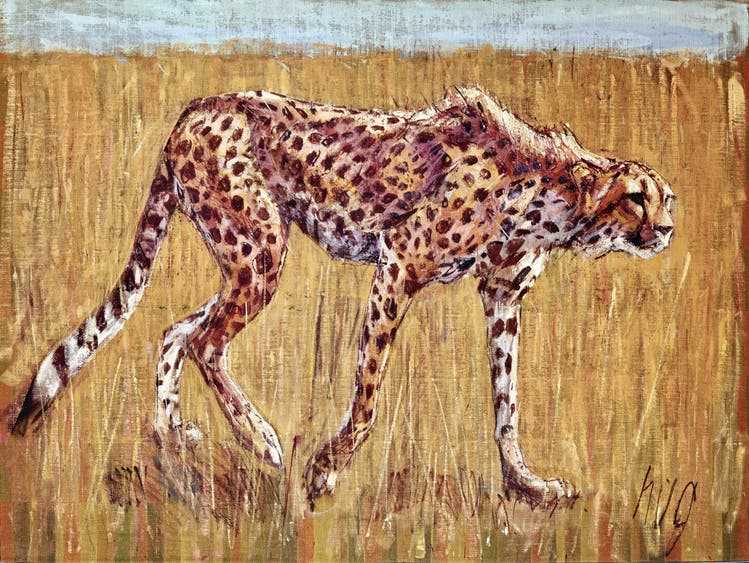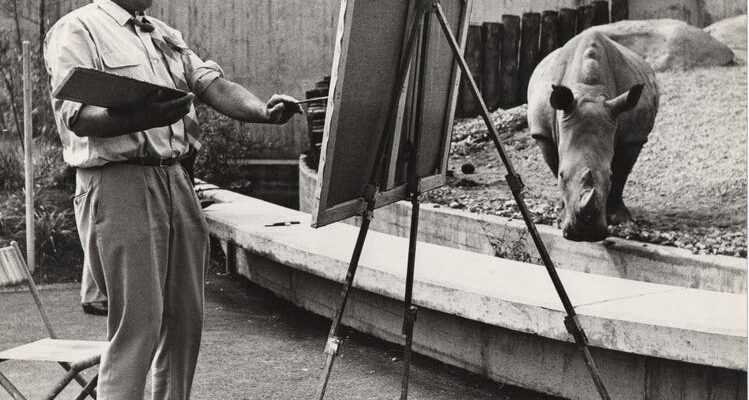Fritz Hug (1921–1989) was an extremely popular and successful painter who was shunned by art critics. A film and an exhibition now provide new insights.
Fritz Hug at Zurich Zoo, where he often worked.
Anyone who visits the zoo today quickly snaps a lot of pictures – most of them with their mobile phones, older men occasionally also with cameras that have extremely long telephoto lenses attached. Fritz Hug did it completely differently: from the 1950s he placed his easel in front of a zoo enclosure and portrayed lions, rhinos or chimpanzees. It took a while, but the animals are said to have patiently kept still – and in most cases recognized and even expected him.
Working in the warm predator house
Fritz Hug once said that work at the zoo began at a time when he could not afford a heated studio. So he went to paint in the predator or monkey house every day. However, animal painting was also an area of art that had not yet been worked on very extensively, in which he was able to try out new things.
Hug largely taught himself to draw and paint; he left the Zurich School of Applied Arts after a short time. It was “endless practice and copying” before he succeeded in getting the line right the first time. Already at the age of twenty he was able to realize his first exhibition in Zurich; at that time, views of the city of Zurich were still dominant. Study trips to various African countries and Italy followed, where Hug began to draw animals.
Fritz Hug once noted in his diary that it was always assumed that he turned to animals because he was disappointed in people. But that is not the case at all: “I simply prefer to paint animals.” However, he did not simply copy them, but also wanted to depict their character and their state of mind.

“Berber lion” from the Margrit Boegli collection.
A documentary film by director Annette Frei Berthoud now enables a re-encounter with the painter, whom practically every child knew in the 1950s and 1970s. This was mainly due to the fact that Hug’s animal pictures also adorned many calendars and posters. In 1964 he was also able to create a large mural for the hunting pavilion at Expo 64 in Lausanne.
International success also came in the sixties: Hug’s oil paintings were sold all over the world; the British Queen also bought two of his works after an exhibition in London. From 1967 the animal painter worked closely with the WWF and portrayed animals that were threatened with extinction. Hug was a nature conservationist from the very beginning and campaigned for an intact nature, for example with posters. A picture is known, for example, with which he calls for the protection of the Rothenthurmer high moor.
Fritz Hug was an extremely popular and successful painter, but was not well received by the official art world. One of his friends once said that he was “a darling of the public who was shunned by art criticism”. At the end of the 1970s, the conflict with the art critics intensified; the slating of his Helmhaus exhibition to mark the 50th anniversary of the Zurich Zoo gave him a hard time.

Cheetah from the Matthias Dudler collection.
Representational art didn’t count for much at that time. Fritz Hug was probably “simply outdated,” says his son Christoph, who looks after his father’s estate. The successful artist went through phases of depression in the 1980s, but never stopped painting. In 1989 he died after a serious illness.
Even younger collectors
In recent decades, things have gone quiet around the once celebrated artist. But there is a loyal fan and collector community that deals with the work and collects well over 6000 oil paintings by Hugs all over the world. The fact that younger collectors are also interested in Hug’s work is shown by the example of Matthias Dudler, who, together with Annette Frei Berthoud, initiated the current exhibition, in which a representative cross-section of Hug’s works can be seen.
42 works are on display in the Art & Business gallery at Trittligasse 4 – in addition to the large-format animal portraits, there are also impressive landscape paintings and three self-portraits from different eras. The pictures come from the collections of Margrit Boegli, Matthias Dudler and Atelier Hug, which is looked after by Fritz Hug’s children. Fritz Hug can be discovered not only as a painter, but also as a person who dedicated himself early on to nature and species conservation and was therefore ahead of his time.
The exhibition Fritz Hug – the animal as I see it can be seen in the Art & Business gallery, Trittligasse 4, until March 26th. Open Mon to Fri 3pm to 7pm, Sat 10am to 3pm. The film is showing at the Houdini cinema and will be shown on Swiss television on April 24 (Sternstunden Kunst).
